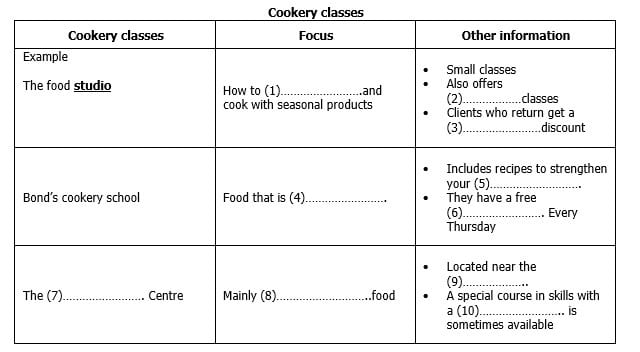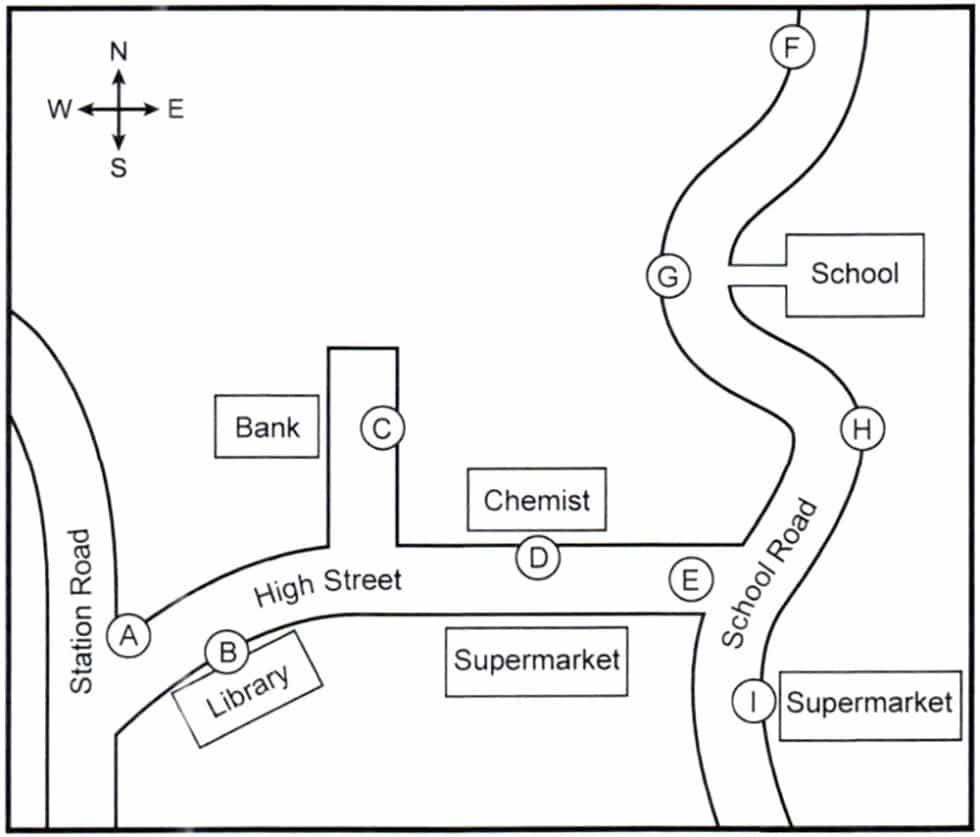Cambridge IELTS 13 Listening Test 1
Cambridge 13 Listening Test 1 – Section 1
Section 1: Questions 1-10
Complete the form below. Write ONE WORD OR A NUMBER.

Cambridge IELTS 13 Listening Test 1 – Section 2
Section 2:
Questions 11 – 13
Choose the correct letter, A, B or C.
Traffic Changes in Granford
11 Why are changes needed to traffic systems in Granford?
A The number of traffic accidents has risen.
B The amount of traffic on the roads has increased.
C The types of vehicles on the roads have changed.
12 In a survey, local residents particularly complained about
A dangerous driving by parents.
B pollution from trucks and lorries.
C inconvenience from parked cars.
13 According to the speaker, one problem with the new regulations will be
A raising money to pay for them.
B finding a way to make people follow them.
C getting the support of the police.
Questions 14-20
Label the map below.
Proposed traffic changes in Granford

Write the correct letter, A-I, next to Questions 14-20
14. New traffic lights __________________
15. Pedestrian crossing __________________
16. Parking allowed __________________
17. New ‘no parking’ sign __________________
18. New disabled parking spaces __________________
19. Widened pavement __________________
20. Lorry loading/ unloading restrictions __________________
Cambridge 13 Listening Test 1 – Section 3
Section 3:
Questions 21-25
Choose the correct letter A, B or C.
21 Why is Jack interested in investigating seed germination?
A He may do a module on a related topic later on.
B He wants to have a career in plant science.
C He is thinking of choosing this topic for his dissertation.
22 Jack and Emma agree the main advantage of their present experiment is that it can be
A described very easily.
B carried out inside the laboratory.
C completed in the time available.
23 What do they decide to check with their tutor?
A whether their aim is appropriate
B whether anyone else has chosen this topic
C whether the assignment contributes to their final grade
24 They agree that Graves’ book on seed germination is disappointing because
A it fails to cover recent advances in seed science.
B the content is irrelevant for them.
C its focus is very theoretical.
25 What does Jack say about the article on seed germination by Lee Hall?
A The diagrams of plant development are useful.
B The analysis of seed germination statistics is thorough.
C The findings on seed germination after fires are surprising.
Questions 26-30
Complete the flow-chart below.
Choose FIVE answers from the box and write the correct letter, A-H, next to Questions 26-30
A container B soil C weight D condition
E height F colour G types H depths
Stage in the experiment
Select seeds of different 26…………… and sizes.
↓
Measure and record the 27……………. and size of each one.
↓
Decide on the 28……………… to be used.
↓
Use a different 29…………….. for each seed and label it.
↓
After about 3 weeks, record the plant’s 30……………… .
↓
Investigate the findings.
Cambridge 13 Listening Test 1 – Section 4
Section 4: Questions 31-40.
Complete the notes below. Write ONE WORD ONLY for each answer.
Effects of urban environment on animals
Introduction
Recent urban developments represent massive environmental changes. It was previously thought that only a few animals were suitable for city life e.g.
• The (31) _____________ Because of its general adaptability
• The pigeon – because walls of city buildings are similar to (32) _____________
In fact, many urban animals are adapting with unusual (33) _____________
Recent research
• Emilie Snell-Rood studied urbanized mammal specimens from museums in Minnesota
– She found the size of their (34) _____________ had increased
– She suggests this may be due to the need to locate new sources of
(35) _____________ and to deal with new dangers
• Catarina Miranda focused on the (36) _____________ of urban and rural blackbirds.
– She found urban birds were often braver but were afraid of situations that were
(37) _____________
• Jonathan Atwell studies how animals respond to urban environments
– He found that some animals respond to (38) _____________ by producing lower levels of hormones.
• Sarah Partan’s team found urban squirrels use their (39) _____________ to help them communicate
Long- term possibilities
Species of animals may develop which are unique to cities. However, some changes may not be (40) _____________
Cambridge IELTS 13 Listening Test 1 Answers
Practice with Expert IELTS Tutors Online
Apply Code "IELTSXPRESS20" To Get 20% off on IELTS Mock Test
1. choose
2. private
3. 20%
4. healthy
5. bones
6. lecture
7. arretsa
8. vegetarian
9. market
10. knife
11. B
12. C
13. B
14. E
15. D
16. B
17. G
18. C
19. H
20. I
21. A
22. C
23. B
24. C
25. B
26. G
27. C
28. H
29. A
30. E
31. crow
32. cliffs
33. speed
34. brains
35. food
36. behaviour
37. new
38. stress
39. tails
40. permanent
Also Check: 10 Top Confusing IELTS Grammar Phrases for IELTS Aspirants
Practice: Practice Cambridge IELTS 15 Listening Test 4 with Answers





Good